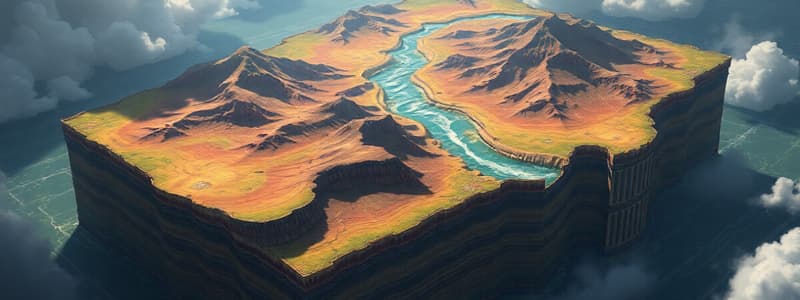Podcast
Questions and Answers
What is a key difference between convergent land to land boundaries and land to ocean boundaries?
What is a key difference between convergent land to land boundaries and land to ocean boundaries?
- Land to land boundaries primarily create oceanic trenches.
- Land to ocean boundaries typically result in mountain ranges.
- Land to ocean boundaries lead to the formation of continental plates.
- Convergent land to land boundaries often produce folded mountains. (correct)
How does oceanic crust differ from continental crust?
How does oceanic crust differ from continental crust?
- Continental crust contains more water than oceanic crust.
- Continental crust is primarily basalt, whereas oceanic crust is granite.
- Oceanic crust is thicker and less dense than continental crust.
- Oceanic crust is thinner and denser than continental crust. (correct)
What do convection currents in the Earth's mantle primarily cause?
What do convection currents in the Earth's mantle primarily cause?
- The cooling of the Earth's core.
- The movement of tectonic plates. (correct)
- The melting of oceanic crust.
- The formation of the Earth's crust.
Where is the Ring of Fire located?
Where is the Ring of Fire located?
What typically forms over hotspots?
What typically forms over hotspots?
Flashcards are hidden until you start studying
Study Notes
Convergent Boundaries
- Land to Land Boundaries: Form where two continental plates collide, leading to the formation of mountain ranges and resulting in earthquakes. Example includes the collision of the Indian and Eurasian plates forming the Himalayas.
- Land to Ocean Boundaries: Occur when a continental plate meets an oceanic plate. The denser oceanic plate subducts beneath the continental plate, creating trenches and volcanic arcs. Example includes the Pacific Plate subducting beneath the North American Plate.
Oceanic vs. Continental Crust
- Oceanic Crust: Thinner (approximately 5-10 km), denser (about 3 g/cm³), primarily composed of basalt. Forms the ocean floor.
- Continental Crust: Thicker (approximately 30-50 km), less dense (about 2.7 g/cm³), mainly made of granite. Forms the landmass and is older than oceanic crust.
Convection Currents
- Mechanism: Driven by heat from the Earth's core, molten rock in the mantle rises and cools, then sinks back down, creating a cycle. This movement influences tectonic plate activity.
- Function: Convection currents distribute heat within the mantle, causing tectonic plates to move, leading to geological events such as earthquakes and volcanoes.
Ring of Fire
- Definition: A horseshoe-shaped zone of high seismic and volcanic activity surrounding the Pacific Ocean.
- Location: Extends from the coasts of South America, up along the western coasts of North America and Asia, around the islands of Japan, and down to New Zealand.
Hotspots
- Formation: Areas in the Earth's mantle where hot magma rises to the surface, creating volcanoes. They are not related to plate boundaries.
- Example: The Hawaiian Islands formed over a stationary hotspot beneath the Pacific Plate, as the plate moved over the hotspot creating a chain of islands.
Studying That Suits You
Use AI to generate personalized quizzes and flashcards to suit your learning preferences.




